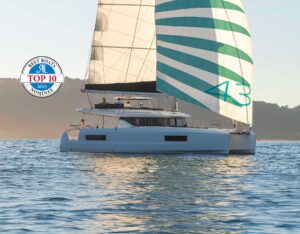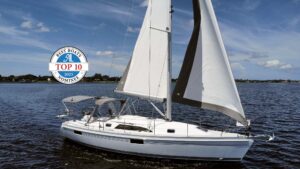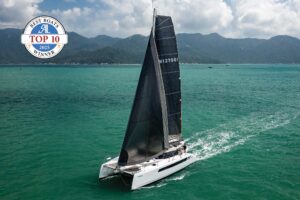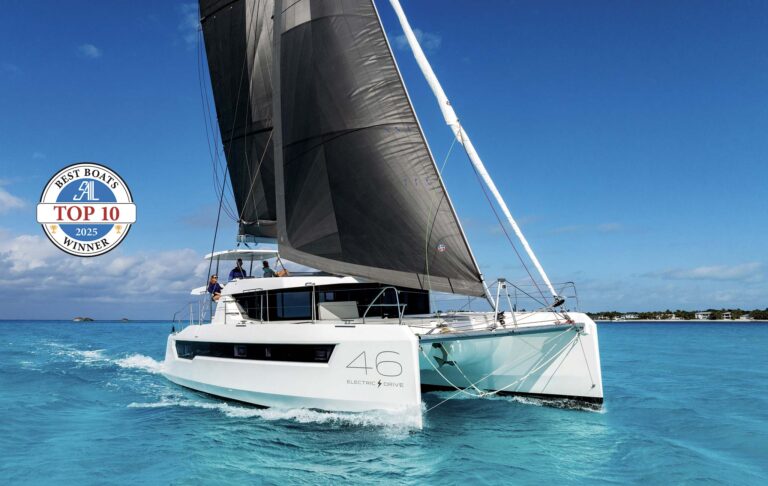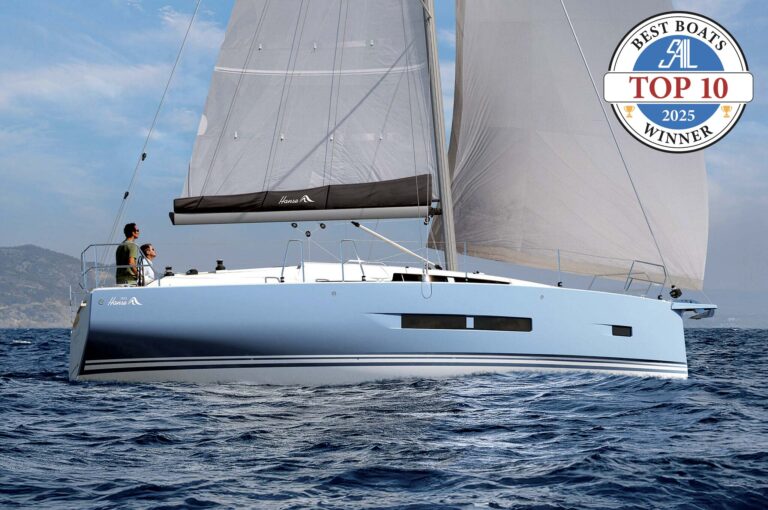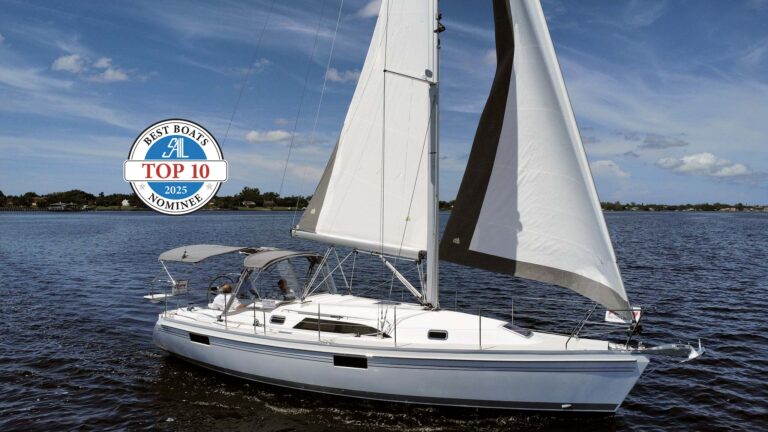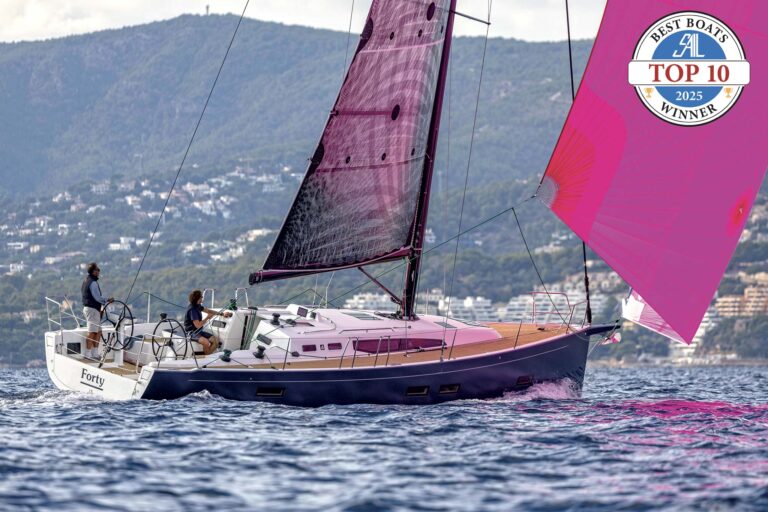The words sleek and fast aren’t normally associated with the Prout name. Words like “sturdy” and “well-finished” more typically come to mind. Nonetheless, the new Prout 50SW is very different from the—how to say this diplomatically—peculiarly English Prouts of the 1980s and 1990s. The signature mast-aft rig of those earlier boats, with their tiny mainsails and huge jibs, is long gone, as is the bulging nacelle between the hulls. I realized as soon as I saw the 50SW that this would be a cat with a very different temperament.
UNDER SAIL
Despite some minor rig problems—not unusual in a brand-new design—the Prout 50SW sailed well in a January test sail off Miami, Florida. We showed 7 to 8 knots of boat speed on the GPS as the wind dropped into the 8- to 12-knot range. Considering the boat is loaded down with marble and wood joinery, I was startled enough to recheck the design specifications several times. The rig has a lot of sail for pushing the boat’s narrow hulls, and they appear to offer little resistance, as evidenced by the exceptionally clean wake and smooth handling.

The big cat tacked gracefully through 95 degrees and showed good acceleration. The factory engineers had wondered if the rudders should be larger, as they look small in the drawings, but they seemed perfectly adequate. The minor tweaking that the Prout design team has in mind should make the boat’s windward ability even better. Grins were everywhere.
The helm station, located in an opening in the cockpit’s hard top, has perfect visibility and sports a beautiful carbon-fiber steering wheel. Although there is a rope bin beside the wheel, it is not large enough for all the control lines that lead there. From the wheel one giant step takes you out onto the cabintop where the shoulder-high boom is easy to reach all along its length. A double mainsheet is mounted on the hard top.
Accommodations

The Prout 50SW’s hindquarters are as curvaceous as a beauty pageant, and the cockpit will entertain a crowd dockside, at anchor or underway. Access via the stern steps or side decks is easy. The only disadvantage to all the curves is that none of the seats, also curved, are long enough for sleeping.
Large sliding doors open onto a big, elegant saloon, finished in fine cherry joinery. The galley will serve a multitude for drinks or eight for a meal at a huge semicircular settee. The nav station has excellent visibility and space for a folded chart, although most of the navigation done on this boat will be electronic. In inclement weather, simply stay inside and pretend you’re on a trawler.
Fine furniture is everywhere. The saloon table carries a beautifully inlaid top, the countertops are marble and the upholstery is leather. Stylish carbon-fiber saloon chairs carry the Prout logo. It’s all very lovely and tasteful.

Our test boat was the four-cabin version, with similar port and starboard hull layouts. Each aft cabin has both a double berth and a pilot bunk. This is a nice combination; the pilot berth will be a cozy place for an off-watch crewmember to sleep at sea. The aft cabin is a very pleasant space, with three opening ports topside, quality woodwork in the lockers and genuine leather on the hull ceilings and overheads. The private head (with a marble countertop, of course) has a separate shower stall.
The forward cabins are almost as spacious, but the double berth is up four steps and extends into the bridgedeck. Because that puts it at shoulder height when you are standing on the cabin sole, you literally have to climb up into bed. The head is forward and has its own shower compartment. There is plenty of flexibility for customizing, and one plan shows an “owner’s version” with an entire hull dedicated to an owner’s suite.
Judging not only by the finish work, but also by the basic structure and systems, the factory in China has top-notch engineers and craftsmen.
UNDER POWER
I joined a full complement of company officials at the close of the Miami boat show for the maiden voyage. Among them was Stephen Cockroft, head of Prout’s multihull sailboat division. Although a cold front had recently blasted through, the wind had moderated to a lovely breeze with occasional puffs to 20—perfect for a daysail.

Motoring out onto Biscayne Bay, the boat was extremely quiet. I measured 62 dBA in the saloon with the engines at 2,200 rpm and detected only 68 dBA next to the engine compartment in an aft cabin. For reference, the level of normal speech is about 68 dBA, with each additional 3 dBA representing a doubling of the sound level. In other words, the engine noise in the saloon is one fourth as loud as the conversation between two crew members. This kitty has a mighty quiet purr.
Running the engines at 2,200 rpm yielded 8.1 knots of boatspeed. At slower maneuvering speeds, the big cat turned nimbly in 11/2 boatlengths and pirouetted in place when the two engines were pushing in opposite directions. Throughout the powering tests, the 50SW gave clear and positive responses, though the folding props did take a moment to open when I reversed them.
CONCLUSION
This is a refined design that’s been carefully constructed at an efficient new factory with qualified labor backed by a diversified parent organization. A rising economic tide should certainly lift this boat.
LOA 50ft
LWL 43ft 10in
Beam 27ft 4in
Draft 5ft 6in
Displacement 32,000lb

